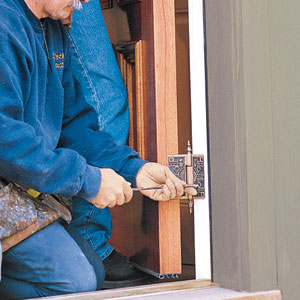
How to Stop a Wood Door from Sticking
A properly hung door should sit square in its opening, easily swinging open and shut. But if it's rubbing or sticking, and the door itself hasn't racked—check its corners with a square to find out—try these antisagging remedies, arranged in order from easiest to most difficult.
Tighten loose screws. Open the door halfway and pull upward on the handle. If any of the hinge leaves move, the screws need tightening.
Fill stripped holes. A screw in a stripped hole will turn endlessly and never tighten. Take it out, fill the hole with a sliver of wood dipped in glue, let dry, and refasten the screw.
Pull in the jamb. Remove one screw from the top hinge where it attaches to the jamb. Put in a 3-inch-long replacement to move the jamb closer to the stud.
Swap the bottom and top hinges. Old hinge leaves at the top of the door bend slightly with age and countless door openings. The bottom hinge should be straighter.
Add shims. Place them behind the bottom hinge leaves to push the door's bottom corner closer to the latch-side jamb.
Tighten loose screws. Open the door halfway and pull upward on the handle. If any of the hinge leaves move, the screws need tightening.
Fill stripped holes. A screw in a stripped hole will turn endlessly and never tighten. Take it out, fill the hole with a sliver of wood dipped in glue, let dry, and refasten the screw.
Pull in the jamb. Remove one screw from the top hinge where it attaches to the jamb. Put in a 3-inch-long replacement to move the jamb closer to the stud.
Swap the bottom and top hinges. Old hinge leaves at the top of the door bend slightly with age and countless door openings. The bottom hinge should be straighter.
Add shims. Place them behind the bottom hinge leaves to push the door's bottom corner closer to the latch-side jamb.

No comments:
Post a Comment
Hi, please feel free to share your comment here.
For example: Which pictures is the best?
Thanks,
Admin